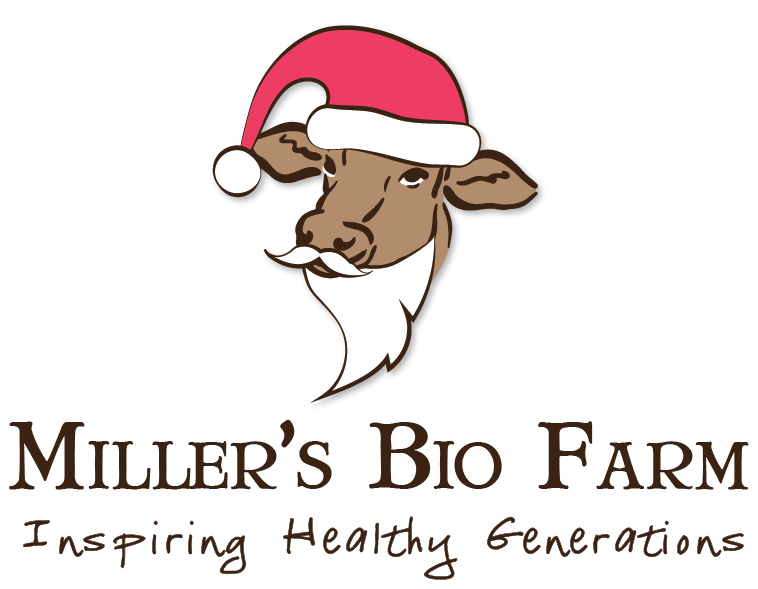Raising Pork the Old-Fashioned Way: Miller's Bio Farm's Commitment to Quality
At Miller's Bio Farm, we're not trying to reinvent the wheel, we're bringing back the farming practices that sustained communities for generations. As an Amish farm, we understand that good stewardship of the land and animals isn't just about business; it's about honoring creation and providing wholesome food for families.
When you buy pork from us, you're getting more than just meat. You're getting the result of careful, intentional farming that puts the well-being of our animals, our land, and your family first.
Let's be honest: most grocery store pork comes wrapped in pretty words like "natural" and "humanely raised," but these labels often don't mean much. It's easy to put nice words on a package, much harder to actually do the work of raising animals properly.
We'd like to show you how we do things differently here at Miller's Bio Farm.
What Makes Our Pork Different
Good pork starts with good practices. For us, that means healthy soil, happy animals, responsible harvesting, and thoughtful management of everything that happens on our farm.
Here's what that looks like in practice:
Pasture-Raised the Way Nature Intended
Pigs aren't meant to spend their lives standing on concrete in windowless buildings. They're curious, intelligent animals that need fresh air, sunshine, and room to express their natural behaviors, rooting in the dirt, foraging for food, and socializing with other pigs.
On our farm, hogs live outdoors on pasture in the woods where they can do exactly that. We move them regularly to fresh ground, which keeps them healthy and gives the land time to rest and regenerate. This practice, sometimes called rotational grazing is farming wisdom that's been passed down for centuries.
When pigs root and forage on fresh pasture, they're naturally fertilizing the soil and helping plants grow back stronger. The land becomes more fertile season after season, storing carbon and building topsoil instead of depleting it. No chemical fertilizers needed, just pigs doing what pigs do best.
This kind of farming takes more work than confining animals in one place, but it produces better results for everyone involved: healthier pigs, healthier land, and better tasting pork.
Raising Animals with Respect
Our approach to animal care reflects our values as an Amish farming community. We believe animals deserve to be treated with dignity and respect throughout their lives.
Processing with Care
When harvest time comes, we work with a small processor who shares our commitment to humane treatment. Our animals are handled calmly and respectfully, with immediate stunning to ensure they feel no distress.
This isn't just the right thing to do, it also affects meat quality. Animals that are stressed at slaughter produce tougher, less flavorful meat. Properly handled animals yield tender, delicious pork that you can taste the difference in.
Studies also confirm what traditional farmers have long known: animals raised on pasture produce meat with better nutritional profiles, including higher omega-3 fatty acids and more vitamins.
Wholesome Feed, No Shortcuts
We raise heritage breed pigs, traditional breeds known for their hardiness and flavor. These animals thrive on pasture with supplemental non-GMO grain, and they don't need antibiotics or growth hormones to stay healthy.
In industrial pork production, antibiotics are mixed into feed daily to prevent disease in overcrowded conditions. This practice is creating drug-resistant bacteria that threaten public health, a problem we don't contribute to.
Our pigs build strong immune systems naturally through good nutrition, clean living conditions, and low-stress environments. It's the way farming worked for centuries before shortcuts became the norm.
Caring for God's Creation
As stewards of the land, we take seriously our responsibility to leave it better than we found it. That's not just good farming, it's part of our calling.
Building Soil, Not Destroying It
Industrial agriculture depletes soil through intensive tilling, chemical dependence, and continuous monoculture cropping. This approach might boost short-term production, but it's not sustainable.
We farm differently. Our rotational grazing actually improves soil health year after year. As pigs move across pasture, they naturally incorporate organic matter into the ground. Rest periods allow plants to regrow with deeper roots, which prevents erosion and captures carbon from the atmosphere.
The result is living, fertile soil teeming with beneficial microorganisms soil that produces nutritious forage without synthetic inputs.
Handling Waste Responsibly
Large scale pig operations often store waste in enormous lagoons that leak pollutants into water supplies and release harmful gases into the air. These systems create environmental and health problems for surrounding communities.
Our approach couldn't be more different. Because our pigs are spread across pasture and woodlands in manageable groups, their manure distributes naturally as valuable fertilizer rather than concentrating into a waste problem.
When winter weather requires us to bring pigs into shelter, we bed them deeply with straw or wood shavings. This creates a composting effect that safely breaks down manure without environmental contamination. We also plant diverse pasture species specifically chosen to absorb nutrients and maintain ecological balance. Not all pigs like to go in the open shelter in the winter time and that's perfectly fine with us!
The Real Story Behind Your Pork Chop
Many people wonder which type of meat is most environmentally friendly. The truth is, it's not so much about whether you're eating pork, beef, or chicken, it's about how that animal was raised.
Take beef as an example. You've probably heard that cattle are terrible for the environment. That criticism applies to feedlot operations where thousands of cattle are confined in small spaces and fed grain-heavy diets. But cattle raised properly on well managed pasture actually improve the land and sequester carbon. The animal itself isn't the problem; the farming method is.
The same principle applies to pork. Factory farmed pork has serious environmental and ethical problems. Pasture raised pork from a regenerative farm like ours is a completely different product.
One challenge specific to pork is that pigs need grain as part of their diet, they can't survive on grass alone like cattle can. This means sustainable pork production requires access to sustainably grown grain, ideally non-GMO corn and soybeans from farmers practicing regenerative agriculture.
On our farm, we're committed to sourcing feed from responsible growers who share our values of soil health, biodiversity, and chemical free farming.
What You're Really Buying
When you purchase pork from Miller's Bio Farm, you're not just buying bacon or pork chops. You're supporting a way of farming that's been proven over generations, one that respects animals, regenerates land, and produces genuinely nutritious food.
We're proud to raise pork the right way, even though it's more work. Because at the end of the day, that's what good stewardship looks like.
And that's something worth bringing home to your table.
Check out our:
✔️Corn & Soy Free
✔️ Vaccine, Drug, GMO-Free
✔️Heritage Breeds
✔️Woodland Raised
PORK COLLECTION HERE: https://millersbiofarm.com/sto...





